All You Need To Know About Barium Impregnated Polyethylene Spheres (BIPS)
Medical ID Systems Inc. is located in Grand Rapids, Michigan. We are a veterinary diagnostics manufacturer that specializes in the use of Barium Impregnated Polyethylene Spheres (BIPS).
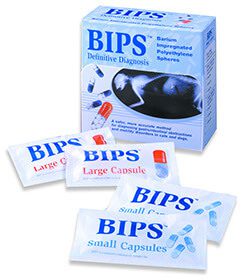
What Are BIPS
BIPS is a mixture of plastic and barium sulfate that is mixed as powders.
The combination is subjected to sufficient heat to render the plastic fluid that is injection molded into precision dies which yield solid, non-dissolving spheres of two sizes (5mm and 1.5mm) containing inexorably bound barium sulfate.
BIPS employs the same barium (barium sulfate) that is in the liquid suspensions used in conventional contrast studies.
BIPS Options
The small capsule option consists of four small gelatin capsules collectively containing one dose of BIPS. The small capsules are easier to administer to cats and small dogs.
The large capsule is more convenient to administer to larger dogs. BIPS are available in two capsule sizes or options. The large capsule option consists of a large gelatin capsule containing one does of BIPS (ie. 10 capsules of 5.0 mm and 30 capsules of 1.5 mm BIPS).
The small capsule are easier to administer to cats and small dogs and consists of four small gelatin capsules collectively containing one dose of BIPS. Administer one large or four small capsules regardless of the animal's size.
BIPS Indications
Each option contains the proper number of large and small BIPS spheres for effective study. The following symptoms are indications for BIPS for a study:
Frequently Asked Questions
The primary function of the large (5mm) is the detection of the gastrointestinal (GI) tract obstructions.
The small BIPS (1.5mm) mimic the passage of food, and their transit through the GI tract provides an accurate estimate of the gastric emptying rate and intestinal transit time of food.
What Diagnostic Purpose Do BIPS Serve?
BIPS provides a range of diagnostic options which reduce the need to undertake exploratory surgery on cats and dogs. Combined with x-rays, spheres of two sizes are used to detect blockages and motility problems in the stomach and intestines.
The spheres are administered in food (or by mouth) avoiding the problem of giving liquid barium by stomach tube and syringe. Unlike liquid barium, the small sized BIPS behave in a similar way to food in the gut.
As they can be counted and gut transit times compared with an average speed for healthy animals, the potential for more accurate diagnosis is greatly improved.
Under What Circumstances Would I Use BIPS?
- Acute Gastrointestinal Complaints – in cases with acute onset of anorexia, vomiting and/or abdominal discomfort, BIPS are useful for ruling out physical obstructions of the pylorus or bowel.
- Chronic Gastrointestinal Complaints – with chronic vomiting or diarrhea, BIPS will help to detect delayed gastric emptying, gastric dumping, partial bowel obstructions, and intestinal motility disorders.
Better sensitivity for detecting these disorders is obtained if BIPS studies are performed with patients that are fed rather than fasted because the food type fed markedly affects gastric emptying rate.
Hill's® Prescription Diet® d/d® must be used in order to make comparisons with the normal values.
- Animals suspected of a partial obstruction – administering BIPS in a high fiber diet is more sensitive than administration on an empty stomach for diagnosing partial obstructions of the intestinal tract with a luminal diameter of 5mm or more.
Fiber accumulates orad to the partial obstruction, arresting passage of the markers. The result: delayed transit and persistent bunching of markers in the abnormal intestinal segment (stagnant loop sign). Carefully examining the bowel area containing the static markers may reveal an intestinal segment dilated by ingesta.
A blockage of the bowel is highly likely if delayed gut transit is associated with a bunching of the BIPS in the small intestine (in two views). A blockage is highly unlikely if abdominal radiographs demonstrate the large BIPS in the colon.
When Do I Shoot My First X-Ray?
BIPS is an interpretative product, the answer depends on the patient’s condition and what you suspect the problem maybe. The BIPS booklet and transit rate charts will provide a more complete explanation.
To rule in or rule out a physical obstruction, you must wait until the large BIPS have had enough time to pass through to the colon (typically 6-24 hours).
Please refer to the transit rate charts in the BIPS booklet to compare your patient’s transit time with a known healthy patient to best determine when to take the x-ray.
Other Aspects to Consider
In some cases, BIPS can be administered and the patient sent home to return the next day for an x-ray. If the large BIPS have reached the colon, then a blockage can be ruled out.
If the large BIPS have not reached the colon, and there appears to be a persistent bunching of the large BIPS in the small intestine, that is highly suggestive of a physical obstruction of the small bowel.
To diagnose for motility disorders, wait until the small BIPS have had enough time to pass part way through the digestive tract (typically 6-16 hours). Please refer to the transit rate charts in the BIPS booklet to compare your patient’s transit time with a known healthy patient to best determine when to take the x-ray.
BIPS travel at the same rate as food, not liquid. This allows you to accurately measure transit time, thus determining possible motility malfunctions. For example, one possibility is that delayed passage of the BIPS, associated with a wide scattering of the BIPS throughout the stomach and small intestine, is usually due to depressed gastrointestinal motility.
However, this does not rule out the possibility of a physical obstruction of the bowel.
Does the Pet’s Weight and Size Determine the BIPS Dose Amount?
No, the dosage is the same for large and small pets.
For the study to be effective, each patient must receive 10 large (5mm) and 30 small (1.5mm) spheres by administering capsules or opening the capsules and sprinkling the BIPS on food.
The recommended number of large and small spheres is inserted in a single gelatin capsule (1” long x 3/8” diameter) which is the preferred option.
If an animal isn’t able to swallow the single, larger capsule, the same number of spheres (10 large, 30 small) can be given in four smaller capsules, which is the recommended dosage if the small capsules are being used.
Aren’t BIPS Too Expensive When Compared to a Liquid Procedure?
No, BIPS are actually much less expensive. When making comparisons, please consider the total procedure cost. Using BIPS, many times you’ll need only one x-ray to obtain an accurate diagnosis.
Give the animal one capsule, wait the desired amount of time, and then shoot an x-ray. Compare this with a liquid procedure, the time needed to shoot multiple x-rays, the personnel involved, the interruption of a busy practice, and the clean up before and after use.
We offer Small, Large, and Dual Packs
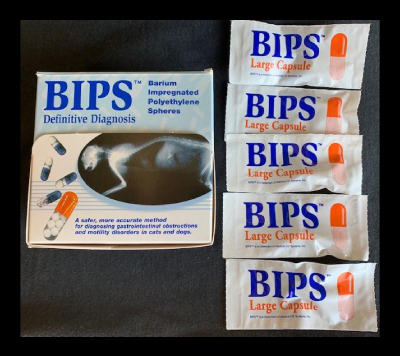
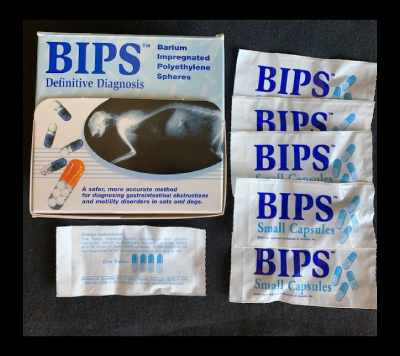
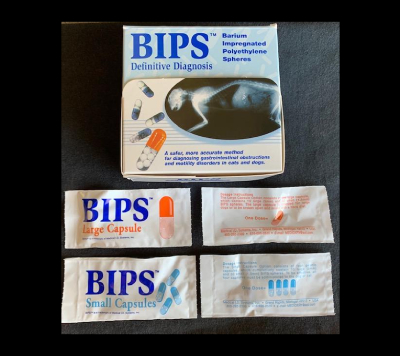
The BIPS Capsule
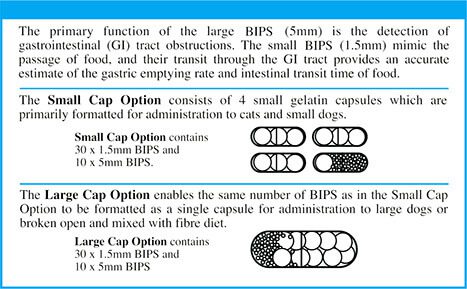
Transit Rate Charts
Transit Rate Charts highlight the research conducted at Massey University in New Zealand. The studies document gastric rate and orocolic transit times in healthy animals.
Used in conjunction with BIPS, this series of charts provides a benchmark to compare your patient’s transit time with known healthy patients for determining the most appropriate diagnosis and/or when to take the x-ray.
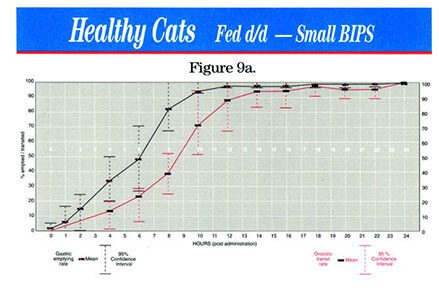
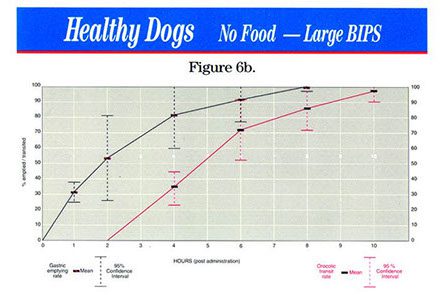
Veterinary Products
BIPS Diagnostic Procedure
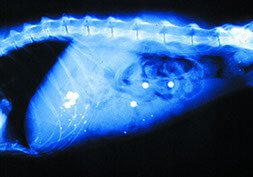


Client Feedback
"The MED I.D. x-ray system makes identifying radiographs fast and safe. The names are permanent, and MED I.D. is inexpensive, effortless and consistent."
- Susan Cornell, Orthodontic Associates Inc.
"The clarity and readability of MED I.D. x-ray identification tape is excellent."
- Harriet White, PMAC
"We're very pleased with the quality and clarity of MED I.D. x-ray labels. The labels come out consistently clear and sharp, both in the hospital and in the field. They have been superior to other x-ray labeling systems we have used."
- Nat Messer, DVM
Let Us Assist You
Get in touch with our team to find out more about the variety of veterinary products we supply.
